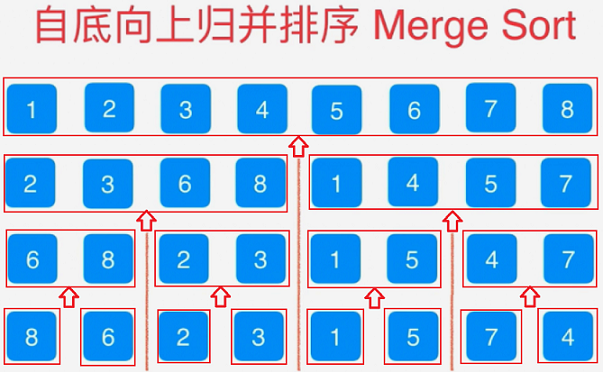分析
-
本题的考点:归并排序、堆。
-
本题有两种比较经典的解法,这里都讲解一下。
自底向上归并排序
- 类似于归并排序,如下图,这里使用自底向上归并排序,每一行代表当前还剩余多少链表没有被合并,当最终合并成一个链表时,就是答案。这里合并两个链表会用到:Leetcode 0021 合并两个有序链表。

堆(优先队列)
- 使用小顶堆,每次取出堆顶元素,此时一定是最小的元素,放到结果链表中,直到堆为空。这里的难点关键是如何实现堆中放入链表?(其实放入的只是链表的头指针)
代码
- C++
// 自底向上归并排序
class Solution {
public:
ListNode *merge(ListNode *l1, ListNode *l2) {
if (l1 == NULL) return l2;
if (l2 == NULL) return l1;
if (l1->val < l2->val) {
l1->next = merge(l1->next, l2);
return l1;
} else {
l2->next = merge(l1, l2->next);
return l2;
}
}
ListNode *mergeKLists(vector<ListNode *> &lists) {
if (lists.empty()) return NULL;
for (int step = 1; step < lists.size(); step += step) // 每次合并的两个链表的索引差值
for (int i = 0; i + step < lists.size(); i += step + step) // i 代表两个待合并链表中的第一个
lists[i] = merge(lists[i], lists[i + step]);
return lists[0];
}
};
// 堆
class Solution {
public:
struct Cmp {
// STL容器在比较的时候用的是结构体的小括号运算符
bool operator() (ListNode *a, ListNode *b) {
return a->val > b->val;
}
};
ListNode *mergeKLists(vector<ListNode *> &lists) {
priority_queue<ListNode*, vector<ListNode*>, Cmp> heap; // 小顶堆
auto dummy = new ListNode(-1), tail = dummy;
for (auto l : lists) if (l) heap.push(l);
while (heap.size()) {
auto t = heap.top();
heap.pop();
tail = tail->next = t;
if (t->next) heap.push(t->next);
}
return dummy->next;
}
};
- Java
// 自底向上归并排序
class Solution {
// 返回l1和l2合并后链表的头结点
private ListNode mergeTwoList(ListNode l1, ListNode l2) {
if (l1 == null) return l2;
if (l2 == null) return l1;
if (l1.val < l2.val) {
l1.next = mergeTwoList(l1.next, l2);
return l1;
} else {
l2.next = mergeTwoList(l1, l2.next);
return l2;
}
}
public ListNode mergeKLists(ListNode[] lists) {
if (lists == null || lists.length == 0) return null;
for (int step = 1; step < lists.length; step += step) // 每次合并的两个链表的索引差值
for (int i = 0; i + step < lists.length; i += (step + step)) // i 代表两个待合并链表中的第一个
lists[i] = mergeTwoList(lists[i], lists[i + step]); // list[i] 和 list[i+step] 进行合并
return lists[0];
}
}
// 堆
class Solution {
public ListNode mergeKLists(ListNode[] lists) {
Queue<ListNode> heap = new PriorityQueue<>((v1, v2) -> v1.val - v2.val);
ListNode dummy = new ListNode(-1), tail = dummy;
for (ListNode l : lists)
if (l != null)
heap.add(l);
while (!heap.isEmpty()) {
ListNode t = heap.remove();
tail = tail.next = t;
if (t.next != null) heap.add(t.next);
}
return dummy.next;
}
}
时空复杂度分析
-
时间复杂度:$O(n)$,
n为所有链表节点之和。 -
空间复杂度:$O(m)$,
m为链表个数。

